
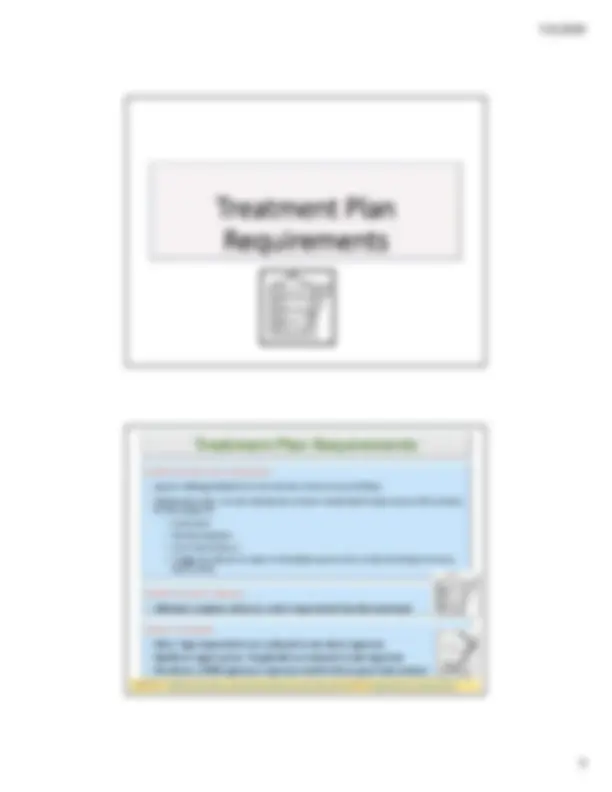
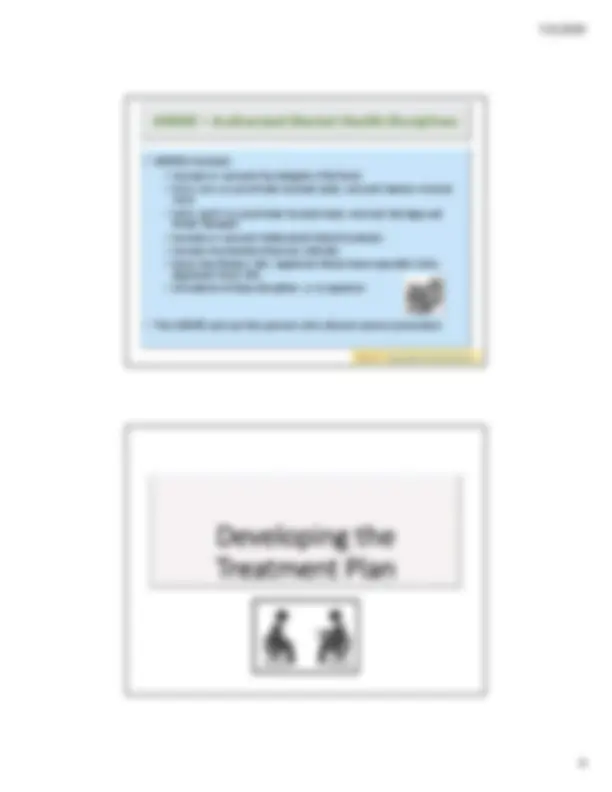
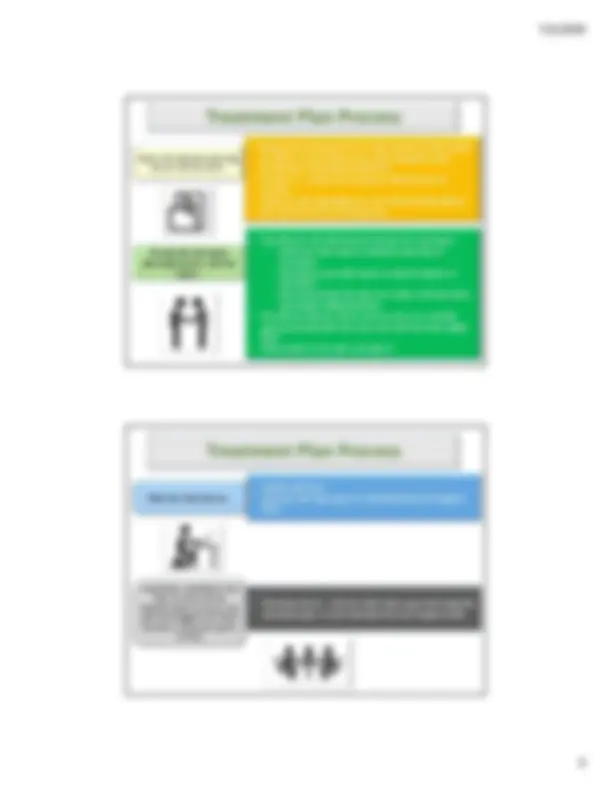
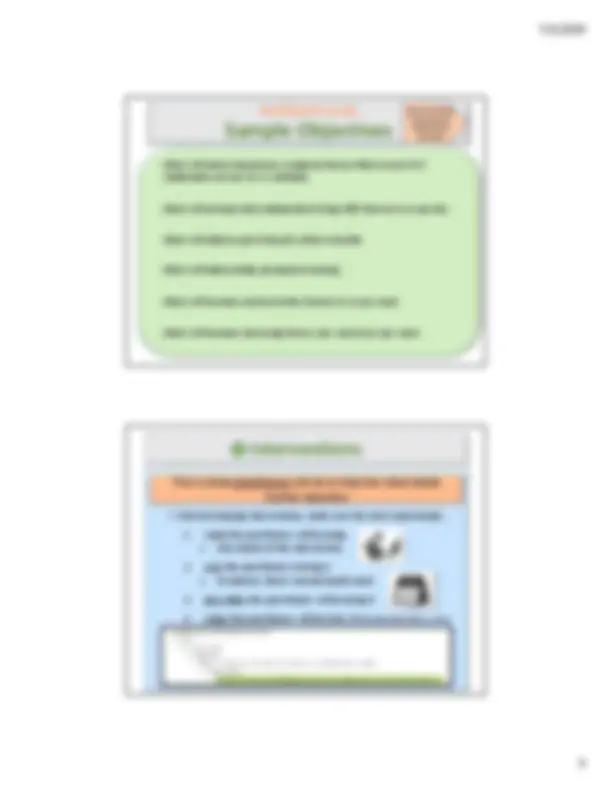
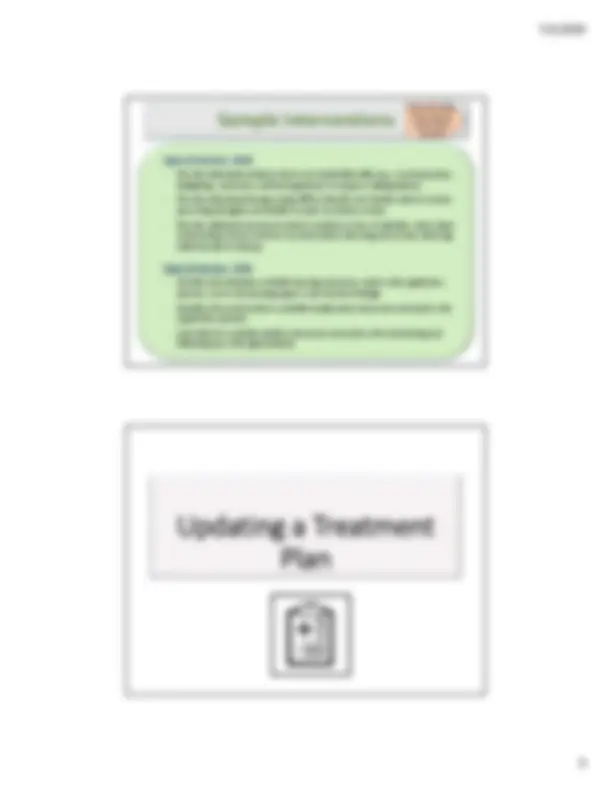
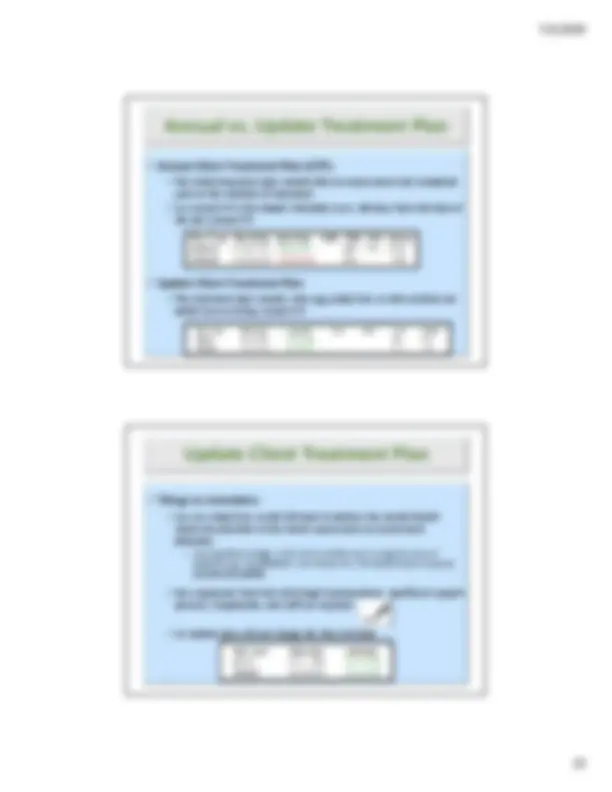
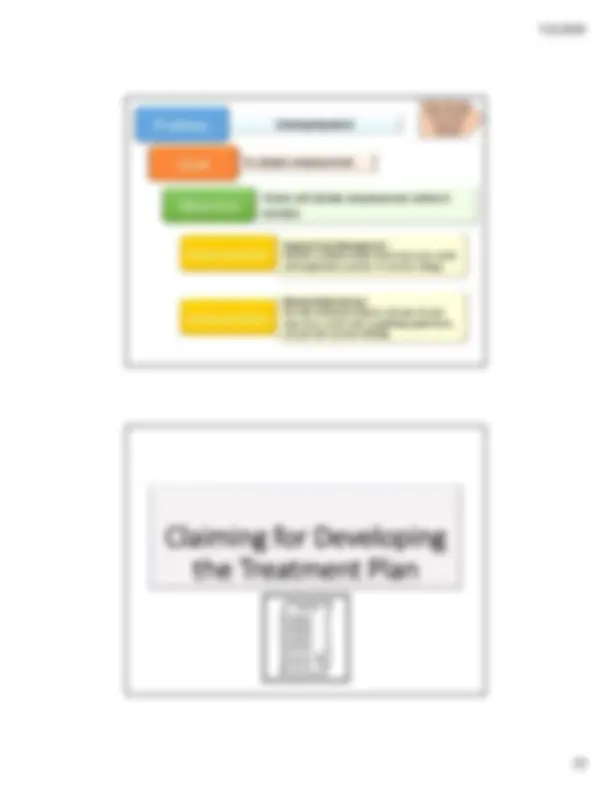
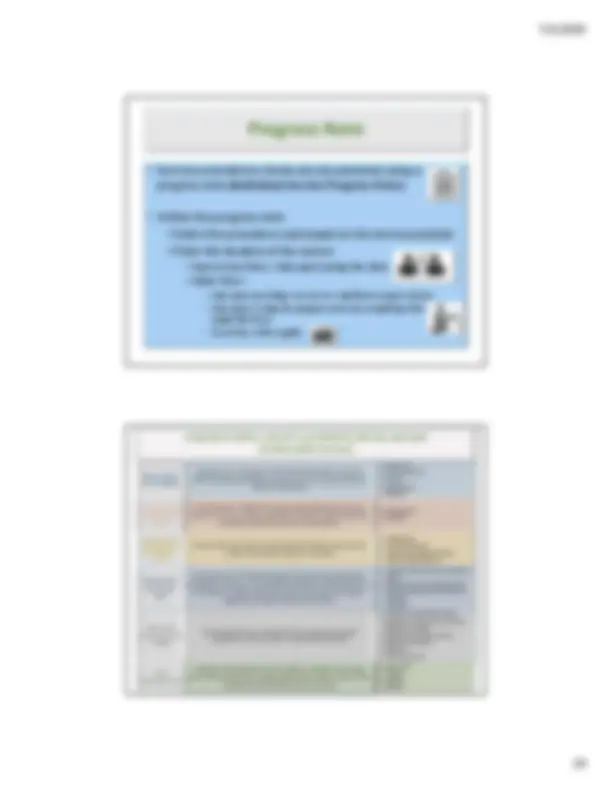
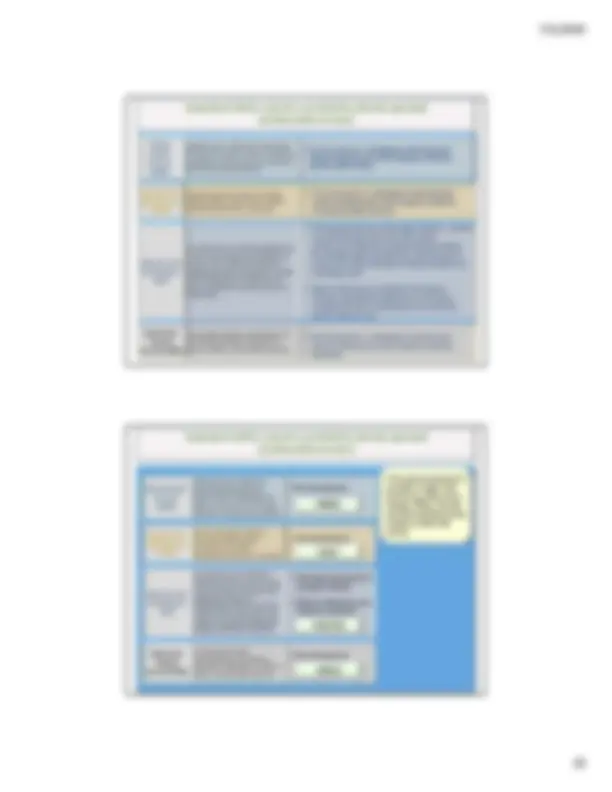
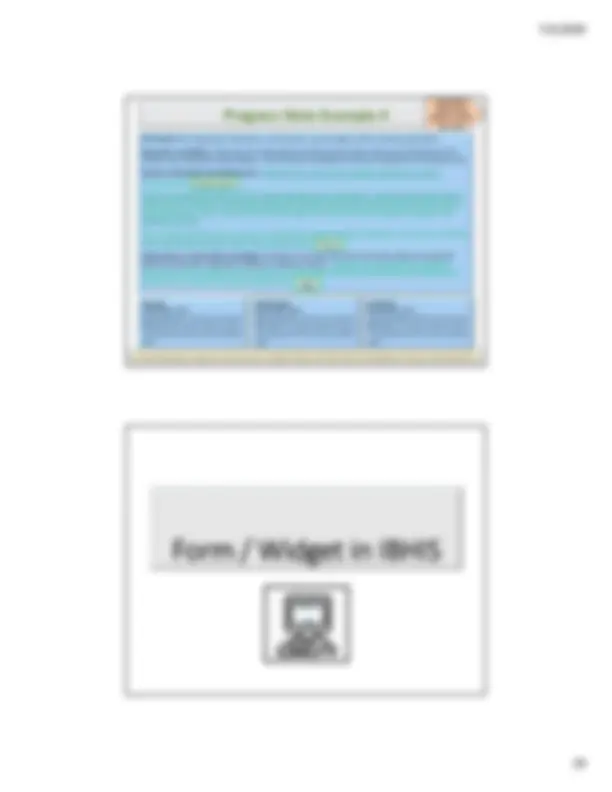
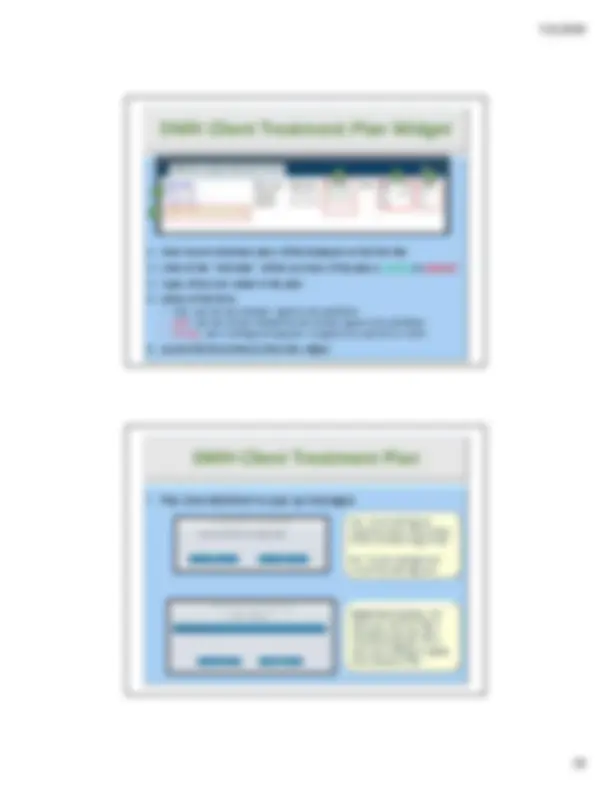
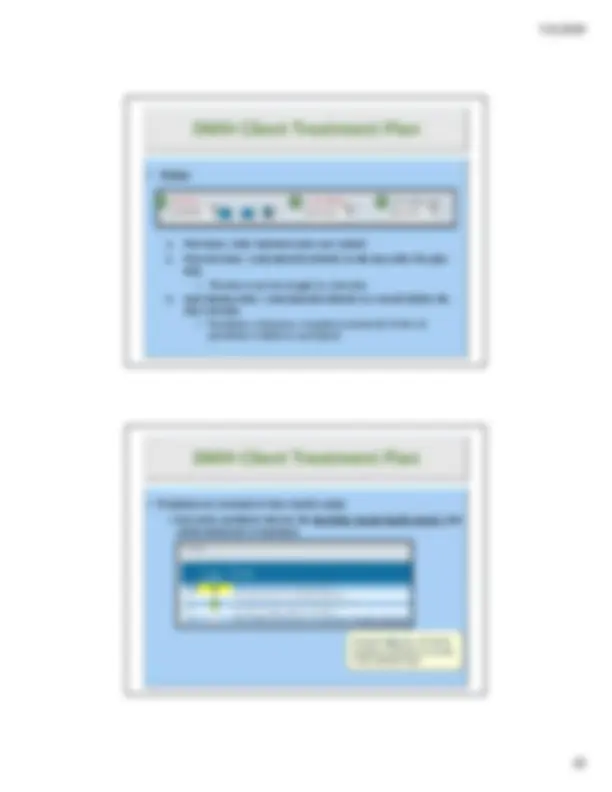
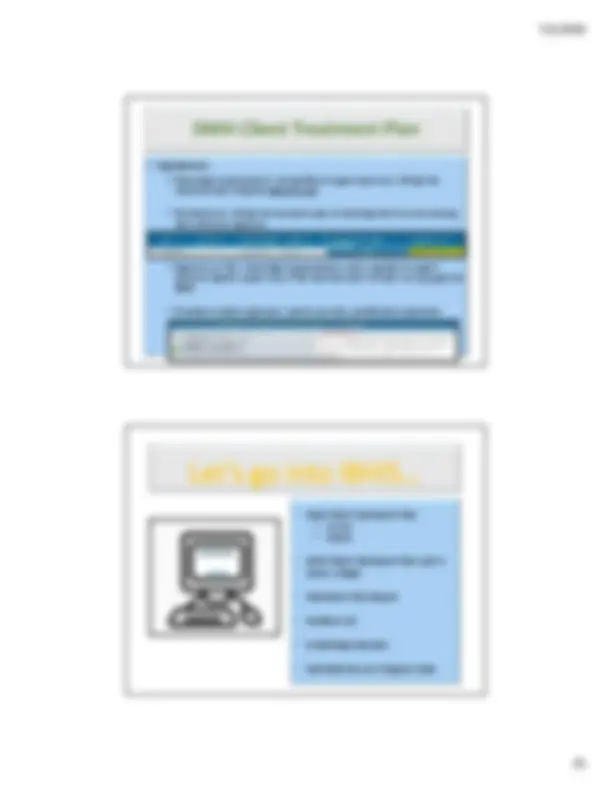
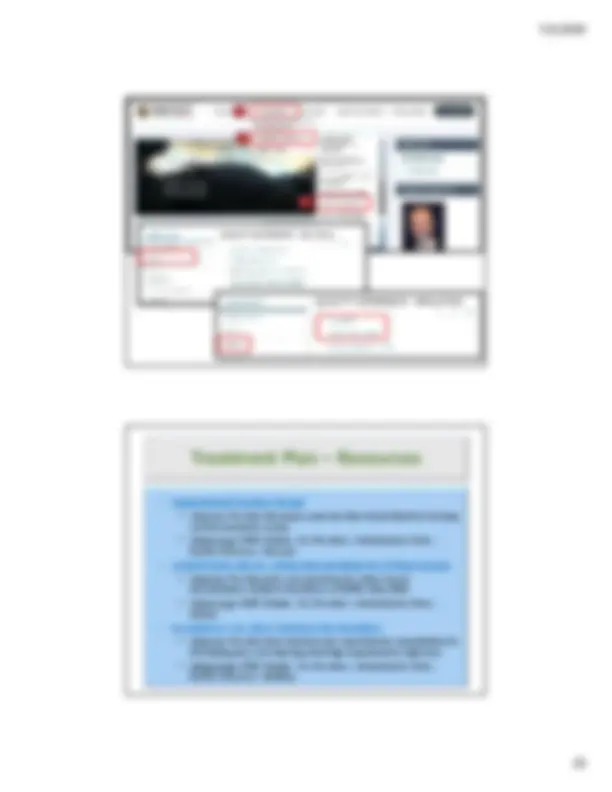


Study with the several resources on Docsity

Earn points by helping other students or get them with a premium plan


Prepare for your exams
Study with the several resources on Docsity

Earn points to download
Earn points by helping other students or get them with a premium plan
Community
Ask the community for help and clear up your study doubts
Discover the best universities in your country according to Docsity users
Free resources
Download our free guides on studying techniques, anxiety management strategies, and thesis advice from Docsity tutors
The requirements and process for developing mental health treatment plans, including who should be involved, what should be addressed, and available types of services. Real-life examples of treatment plans for depression, anxiety, homelessness, and unemployment are provided.
What you will learn
Typology: Slides
1 / 22

This page cannot be seen from the preview
Don't miss anything!















Purpose Requirements Developing a Plan Updating a Plan Examples Claiming for the Service Using IBHIS LACDMH Quality Assurance Unit – Policy and Technical Development Team – 6/17/
Reference: Organizational Providers Manual
Treatment Plan Process During the treatment planning session with the client…
Goals
Objectives
REFERENCE SLIDE Sample Objectives
Pause the video if you want to review these examples Interventions
Annual vs. Update Treatment Plan
Update Client Treatment Plan
o If any significant changes in the client’s condition occur during the course of treatment (e.g. hospitalizations, new trauma, etc.), the treatment plan should be reviewed and updated
Mental Health Service: Provide individual therapy using CBT to identify and modify client’s negative feelings of worthlessness and reinforce active problem-solving skills in order to strengthen self-confidence and improve mood
Mental Health Service: Provide collateral services to client’s spouse so that spouse can assist client better with using his problem-solving skills at home Pause the video if you want to review this example
Targeted Case Management: Identify available employment resources, assist with application process, & monitor linkage
Mental Health Service: Provide individual rehab to role play for job interviews, assist with completing applications, and practice resume building Pause the video if you want to review this example
Mental Health Services (MHS) Individual, group, collateral or family-based interventions to restore a client’s functioning and ability to remain in the community with goals of recovery and resiliency Assessment Plan Development Therapy Rehabilitation Collateral Intensive Home Based Services (IHBS) An intensive form of MHS that is predominantly delivered in the home, school or community. IHBS is specifically intended for children/youth who are already receiving Intensive Care Coordination. Rehabilitation Collateral Medication Support Services (MSS) Prescribing/furnishing, administering and monitoring psychiatric medications to reduce a client’s mental health symptoms Evaluation of the Need for Meds Evaluation of Clinical Effectiveness & Side Effects of Meds Obtaining Information Consent Medication Education Collateral Plan Development Targeted Case Management (TCM) Services that assist a client in accessing needed ancillary resources (e.g. medical, alcohol/drug treatment, vocational) Assessment Plan Development Referral and Related Activities Monitoring & Follow-Up Intensive Care Coordination (ICC) An intensive form of TCM that facilitates the assessment, planning and coordination of services. ICC is specifically intended for children/youth who are involved in multiple child serving systems and require cross-agency collaboration through a Child and Family Team Planning & Assessment of Strengths & Needs Reassessment of Strengths & Needs Referral, Monitoring, and Follow-Up Activities Transition Crisis Intervention (CI) Unplanned and expedited services to address a condition that requires more timely response than a regular appointment in order to assist a client to regain/remain functioning in the community. Assessment Therapy Collateral Referral
During session w/ client, social worker developed the treatment plan and added individual and group therapy to the plan. Plan Development Scenarios During CFT Meeting, client, family, and treatment team agreed that Rehab Specialist will start meeting with the client 2x per week, and Parent Partner will meet with family 1x per week. Treatment Plan was updated to include these services. Community Worker completed the Community Functioning Evaluation w/ client and added an intervention related to finding housing resources to the client’s treatment plan. Medical Case Worker met w/ client for individual rehab. During the session, the treatment plan was updated to include a group rehab intervention. Psychologist met w/ client and parent to complete the assessment and treatment plan.
Therapist and case manager meet to discuss client’s lack of progress in treatment and updates to client’s living situation (client now lives w/ paternal grandmother). Based on increased behaviors and change in caregiver, therapist stated that individual rehab w/ the case manager and collateral sessions w/ the therapist will be added to the client’s treatment plan. Case manager suggested adding targeted case management to assist family w/ finding parenting resources in the community. Case Manager: T Therapist: H Practitioner met with the client for the purpose of developing the treatment plan (refer to treatment plan dated 5/1/20). Client and practitioner agreed that individual therapy and targeted case management would be helpful in addressing client’s anxiety and assisting client with obtaining employment resources. Client signed the treatment plan. At the next session on 5/8/20, practitioner and client will meet to begin individual therapy sessions. Practitioner will consult with the case manager to discuss client’s needs related to employment. Procedure Code: H Face to Face: 36 minutes Other Time: 30 minutes (includes writing the progress note and documenting on the treatment plan form) Progress Note Example 1 Pause the video if you want to review this note Reimbursement Clinical Legal
Practitioner met with the client for the purpose of conducting an assessment and developing a plan for treatment. Refer to the Adult Full Assessment dated 5/3/20 and DMH Client Treatment Plan dated 5/3/20. Client was open to services and forthcoming with sharing information about himself. Client and practitioner agreed to group rehab services to help client learn better communication skills, individual therapy to address trauma, and targeted case management to assist with finding stable housing. Practitioner will complete referral to rehab group and consult with group leaders. At next session, practitioner and client will begin individual therapy sessions. Time not billed: Reviewing consent for services, HIPAA, and confidentiality. Client signed all necessary forms. Procedure Code: 90791 Face to Face: 79 minutes Other Time: 66 minutes (includes writing the progress note and documenting on the assessment and treatment plan forms) Progress Note Example 2 Pause the video if you want to review this note Reimbursement Clinical Legal Goal: Client will decrease depressive symptoms from a PHQ-9 score of 19 to a 4 or less. Intervention: Met with the client for the purpose of conducting an individual therapy session. Administered the PHQ-9 – client’s current score is 19 (moderately severe). Client continues to endorse feeling depressed, feeling like a failure, difficulties falling asleep, and fatigue. Discussed lack of progress towards reducing depressive symptoms. Inquired whether client would be open to adding group interventions to the client’s plan. Also discussed whether client was open to a referral for an initial medication evaluation. Focused on challenging client’s underlying belief related to worthlessness, and modifying his tendency toward global self-rating. Assisted client in using statements to rate his behaviors and not his entire self. Practiced using problem-solving skills with the client to help him effectively address his triggers. Response: Client will continue to practice using statements to rate his behavior rather than his entire self and to continue practicing problem-solving skills. Client agreed to trying group rehab to learn more problem-solving and coping skills. Client also agreed to speak to the psychiatrist to determine if medications might help. Client signed updated treatment plan. Plan: To continue working on modifying self-defeating beliefs and strengthening problem-solving skills. Practitioner will complete a referral for a CBT group which will start on 6/8/20. Group rehab was added to client’s treatment plan. Practitioner made an appointment for client for an initial medication evaluation with Dr. X on 6/10/20. Procedure Code: 90837 Face to Face: 68 minutes Other Time: 21 minutes (includes writing the progress note and documenting on the treatment plan) Progress Note Example 3 Pause the video if you want to review this note Reimbursement Clinical Legal
Final – plan has been finalized / signed by the practitioner Draft – plan has not been finalized and has not been signed by the practitioner Pending - plan is waiting to be approved / co-signed by a supervisor or AMHD
DMH Client Treatment Plan Widget 1
This date cannot be changed to a later date
Practitioner will receive a reminder in his/her My To Do’s (if practitioner is listed as a participant) DMH Client Treatment Plan 1 2 3
DMH Client Treatment Plan Excluded diagnoses will not be selected as problems to include in the treatment plan